► Behind the scenes at Alfa squad’s first F1 test
► Brand returns to F1 after 34 years
► Tracking Kimi Raikkonen’s progress at Barcelona
The last time an Alfa Romeo Formula 1 team entered a Grand Prix was in Australia, 1985. In the same country on 17 March 2019 it’ll be back.
The Alfa name returned to F1 in 2018 as title sponsor of the Sauber team; for 2019 the entire team and its championship entry is renamed Alfa Romeo Racing (although its structure, ownership and management remain the same). CAR was a fly on the wall to see the Alfa Romeo’s first test as an official F1 team in more than 30 years.
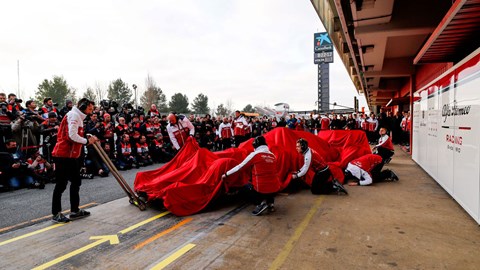
Showtime in Spain
A fashionably late half-hour before the first official test session of the year began, drivers Kimi Raikkonen and Antonio Giovinazzi pulled the covers from the Alfa Romeo Racing C38 under the cool morning sun in the pitlane at Barcelona’s Circuit de Catalunya, its smart red and white livery flickering under the flashbulbs of a throng of photographers.
No sooner has the photocall begun than it’s over, the team’s engineers anxious to get the car prepped for first practice. It’s spirited away into the garage on trolley jacks and we’re allowed to squeeze under the roller door for a closer look.
CAR’s guide to the F1 2019 season
The C38 looks fantastic up close, its livery a combination of the Sauber team’s traditional white and blue, and Alfa’s red. It couldn’t have been entirely red, of course, for risk of confusion on camera with the team from Maranello further down the pitlane.
Inside the garage we spot FCA design chief Klaus Busse and Alfa Romeo’s head of exterior design Scott Krugger looking on proudly. They’ve overseen the design of the car’s livery, and seem thrilled at its reception. Krugger tells us the red is the exact same shade as the Alfa Romeo 8C Competizione, applied using the lightest possible type of paint. ‘It’s a nice perk of the job, to design a livery for a new F1 car’, Busse grins. Raikkonen’s car and suit advertise the Giulia’s logo; Giovinazzi’s the Stelvio SUV.
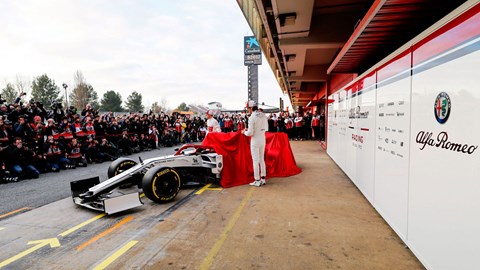
This might be the car’s first official test but it’s previously had shakedowns at Mugello and at Ferrari’s Fiorano test circuit, with Raikkonen behind the wheel. When photos from the latter run emerged (with the car wearing a special Valentine’s Day-themed livery, also designed by Busse and Krugger’s department), its front wing design set tongues wagging. Regulation changes for 2019 have made front wings higher, wider and simpler in an effort to allow cars to run more tightly together without losing downforce, in the hope of creating closer racing. Alfa’s wing design is rather different from the other teams, hoping to mitigate against the loss of downforce compared with last year’s car.
Maybe it’ll be effective, maybe it won’t, but the paddock’s interest is certainly stirred. The design has been overseen by highly rated technical chief Simone Resta, who joined the team last year from Ferrari where he was chief designer. That’s not the only connection to the prancing horse in the Alfa Romeo Racing garage.
Alfa’s F1 return: the background
As with so many things, the late Fiat Chrysler Automobiles (FCA) CEO Sergio Marchionne was the architect of Alfa’s return to F1.
The advantages of Alfa Romeo-badged fingers in the F1 pie are manifold; it gives Ferrari and its FCA parent company extra clout in negotiations with the sport’s governing bodies; it provides a global marketing platform for the Alfa Romeo brand and sprinkles a little F1 fairy dust on its products; and it creates a junior team to curate potential drivers and personnel for the Ferrari team, in the same way that Toro Rosso is a B-team for Red Bull.
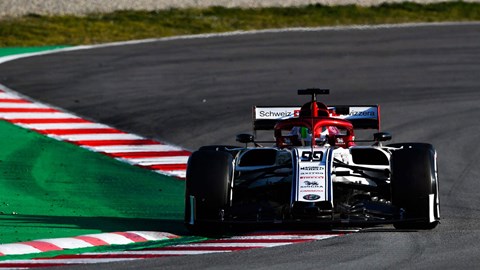
As before, engines are supplied by Ferrari, and 25-year-old Italian driver Antonio Giovinazzi is a Ferrari junior driver; he sat in for two races in the Sauber last year, and now will race full-time.
‘It’s a different name but the same team,’ he tells me. ‘Of course, motivation now is a lot higher than two years ago, because the results are better. I think last year they did a fantastic job. If you look [from the] beginning of the season to the end of the season they improve a lot, and this is our target – to start the season already on the top 10 I would say, like at the finish of the [last] season and work after that.’
Sauber lives on
Alfa Romeo Racing is still operated by Sauber Motorsport AG, and the team’s headquarters remain at Hinwil in Switzerland. (They are one of the few F1 teams not to have at least any outposts in the UK.) The groups other two entities are Sauber Engineering, and Sauber Aerodynamik, both operating as consultancies and development partners with a variety of clients.
Team principal and Sauber Motorsport CEO Frédéric Vasseur tells us Sauber Engineering will work on road car-related projects with Alfa Romeo. ‘We are already working on some other projects together, you will see the result quite soon. Good opportunities for the company to develop the scope of the business, I think it’s a huge opportunity for us. It will involve more the guys at the factory, than the race team.’
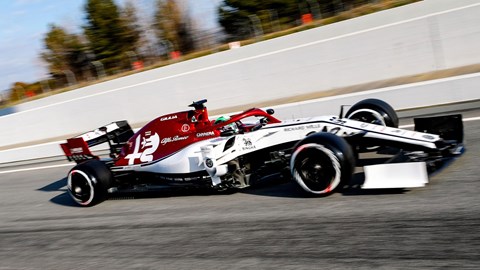
I ask if technical resources have increased dramatically since Alfa Romeo’s involvement:
‘If the reference is from when I joined [from Renault F1 at the end of 2016], it is a lot and we are still increasing. We still have development positions. We are ambitious, Alfa Romeo is ambitious and it is important for Alfa Romeo Racing to be competitive. It is a new responsibility for us, we are not just racing for the company, we are racing for the car manufacturer.’
Sauber has raced in F1 since the early 1990s, and the new car is called the Alfa Romeo Racing C38, continuing Sauber’s tradition of naming its cars after the letter C for Christiane, founder Peter Sauber’s wife.
It was Peter Sauber who gave Kimi Raikkonen his first F1 break, signing him as a 20-year-old wunderkind before the 2001 season. At the time Raikkonen had only competed in only 23 car races. Now the 2007 world champion returns to the team, after his seat at Ferrari was taken by Charles Leclerc – who raced for Sauber last season. Raikkonen has signed with Alfa Romeo for two seasons. Poetically, it’s reputed that Sauber’s state-of-the-art windtunnel was effectively paid for by McLaren, who paid handsomely to buy the talented Raikkonen out of his Sauber contract and sign him for the 2002 season.
Peter Sauber retired in 2016. He’s here today, relaxed and unhurried, talking to former colleagues, sipping coffee and answering his phone. He’s even less talkative than his famous signing, replying to questions with a nod or an inaudible murmur. ‘Is it nice having Kimi back?’ I ask. ‘He’s always been here,’ he answers cryptically.
First laps
Time for Kimi to take to the track for the new car’s first official laps. Other teams watch with interest as the C38 rumbles away down the pitlane, and fires his way up through the gears onto the circuit. Alfa/Sauber mechanics take to the pitwall, awaiting his return. He doesn’t show; red lights wink onto the gantires and the other cars trickle back to the pits. No sign of Kimi. Unexpectedly, he’s had a spin. No harm done though, and the Alfa soon returns, undamaged, on the back of a low-loader.
‘I never seem to learn from the winter that the track is slippery to start’, he tells the assembled media later, with a wry smile. He’s quickly up and running again, and begins reeling off laps for the team to gather data.
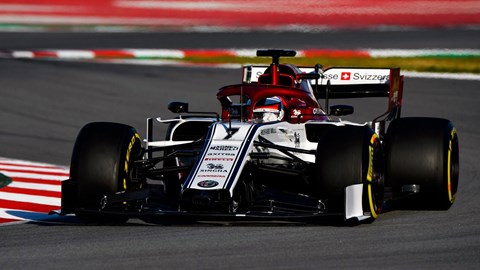
We venture out to the circuit to watch. Barcelona is a fast, flowing circuit with far more elevation change than appears on television. The cars, too, sound more nuanced than they do on TV, a sonic cocktail of whooshes and whirs from motors and turbos in unison with gruff V6 engines. Each car sounds different; Renault’s engine almost a whisper, Mercedes’ raucous and hard-edged, the Honda power unit newly installed in the Red Bull somewhere between the two.
The cars pummel their way through the corners so fast that sound takes a while to catch up, a flurry of downshifts and buzz of tyres against kerbs drifting on the breeze long after the drivers are through the corners. Raikkonen is not the only driver to have a spin; Ferrari’s Sebastian Vettel does too, quickly recovering to become comfortably the quickest driver on track. We watch at one of the fastest corners on the circuit, a blind uphill right-hander that demands breath-taking commitment. Vettel is the only driver who is flat-out through the corner, his Ferrari’s exhaust note never wavering as it kicks up a rooster tail of sparks through the curve. He’ll end the day fastest on the timesheets, with multiple race distances under his belt.
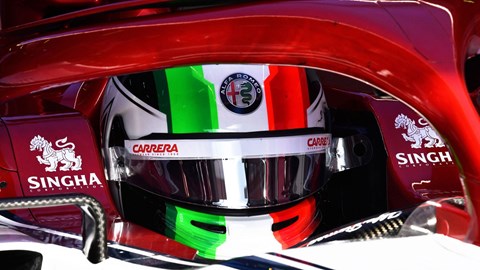
Alfa too have racked up plenty of laps by the time the circuit falls silent for an hour so that marshals and teams alike can get have lunch. Kimi appears relaxed over food in Alfa Romeo’s hospitality unit, chatting and smiling with team members and grabbing a can of Coke (not a Diet one) from the fridge. Meanwhile autograph and selfie-hunters pace outside, patiently waiting for him to emerge.
Said hospitality unit is a two-storey glass-fronted construct between two trucks, using clear glass as opposed to the off-putting privacy tints used by the majority of the other teams. The trucks look smart, in the same livery as the cars.
Lunch over, the new cars’ complex hybrid powertrains are coaxed into life behind shrouds, blocking any investigative photographers’ lenses. When the cars emerge, they look fantastic, the wider wings making them look closer to prettier F1 cars of the 1990s, after a couple of decades spent in the design doldrums.

Various teams are experimenting with data-gathering; Mercedes’ Valtteri Bottas was lapping with what looked like a garden gate attached to his car in the morning, a raft of aero sensors working out the wider airflow’s behaviour around the car; Romain Grosjean’s Haas is spontaneously decorated with ‘flow-vis’ paint along its flanks to answer the same questions at close hand.
As the sun begins to sink and only a few minutes are left on the clock before the chequered flag falls on the first full day of testing of the season, Raikkonen’s car coasts into view on the pit straight, its engine revving but without drive. He pulls onto the grass before the first corner and his first full test is concluded on foot, due to an undisclosed powertrain issue.
Valterri Bottas guide to developing new F1 parts
The team seem upbeat though, and the car has completed more than 100 laps, and posted competitive times (and two days later, Raikkonen will go on to set one of the fastest laps of the week).
‘Everything went smoothly, apart from my spin,’ he smiles. ‘It’s early days and we have a long way to go but I am happy to be a part of Alfa Romeo. Obviously it’s not as big as my previous team but everything is running really nicely. I don’t thing we are [aiming] for a certain position. As long as we do the best we can the results will come. It is impossible to say what they’ll be. The important [thing] is we do the maximum from ourself and then we see. We will see in the first races and we’ll keep working every night and see what we can do.
‘We have a car we can work with. There’s always doubt changing teams – could it be difficult to get things how you like and so on, but so far it’s been a very easy transition. It’s a great group of people. It’s a different team but I don’t feel any different in my driving. We have a long way to go but we’ve had a good day today.’
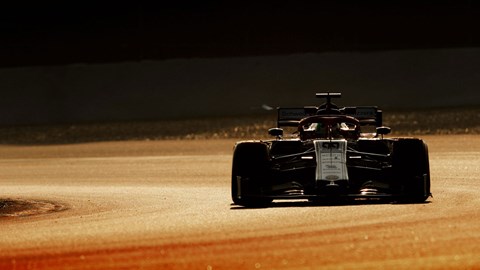
There’s the history, of course. Alfa Romeo won the first ever F1 world championship in 1950 with Nino Farina at the wheel of its beautiful supercharged straight-eight ‘Alfetta’ 158, and again in 1951 with the great Juan Manuel Fangio. And before the world championship existed Enzo Ferrari’s Scuderia was campaigning Alfa Romeos and Tazio Nuvolari was winning legendary races in the iconic Alfa P3 designed by Vittorio Jano.
It’s special to see the logo and name back, even if in some ways it’s in name only. That in itself is nothing new; last time Alfa Romeo raced in F1, its cars were run by the Euroracing team. Whether Alfa Romeo is in F1 as a marketing tool for the road cars, a chess piece in Ferrari’s political standing in the sport, or a combination of both, it’s exciting to have it back, and all the more so that it’s in the hands of an established world champion, a motivated young teammate and a designer with a track record in race-winning cars.
And it will be competing in a championship that looks like, following a few intriguing regulation changes, team changes and driver moves, it could be well worth tuning into this season. Mores the more pity it’s no longer live on free-to-air television in the UK.